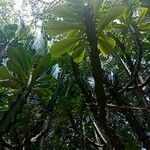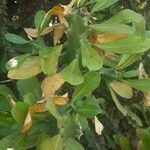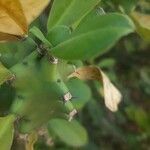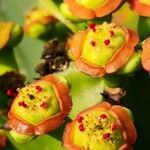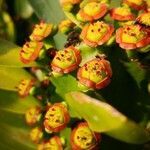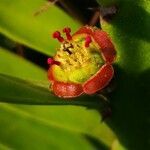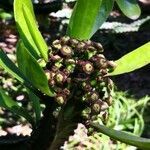| Therapeutic use
|
Fistula (bark), Asthma (flower), Analgesics (leaf), Anthrax (leaf), Anti-bacterial agents (leaf), Anticonvulsants (leaf), Antifungal agents (leaf), Anti-inflammatory agents (leaf), Antirheumatic agents (leaf), Arthralgia (leaf), Burns (leaf), Common cold (leaf), Contusions (leaf), Cough (leaf), Diuretics (leaf), Expectorants (leaf), Fever (leaf), Fractures, bone (leaf), Furunculosis (leaf), Gastritis (leaf), Gout (leaf), Immunomodulation (leaf), Influenza, human (leaf), Insecticides (leaf), Pharyngitis (leaf), Skin diseases (leaf), Vitiligo (leaf), Wounds and injuries (leaf), Visceral obstructions (plant exudate), Hair loss (plant exudate), Anthelmintics (plant exudate), Anticoagulants (plant exudate), Antifungal agents (plant exudate), Antirheumatic agents (plant exudate), Ascites (plant exudate), Asthma (plant exudate), Bites and stings (plant exudate), Blister (plant exudate), Carbuncle (plant exudate), Cathartics (plant exudate), Common cold (plant exudate), Cough (plant exudate), Dental caries (plant exudate), Dermatitis (plant exudate), Diuretics (plant exudate), Dracunculiasis (plant exudate), Earache (plant exudate), Eczema (plant exudate), Edema (plant exudate), Endophthalmitis (plant exudate), Exanthema (plant exudate), Expectorants (plant exudate), Fistula (plant exudate), Headache (plant exudate), Hemorrhoids (plant exudate), Hemostatics (plant exudate), Hepatomegaly (plant exudate), Hypertension (plant exudate), Counterirritant (plant exudate), Jaundice (plant exudate), Leprosy (plant exudate), Neoplasms (plant exudate), Otitis media (plant exudate), Scabies (plant exudate), Scorpion stings (plant exudate), Skin diseases (plant exudate), Snake bites (plant exudate), Suppuration (plant exudate), Tooth mobility (plant exudate), Toothache (plant exudate), Visceral disorders (plant exudate), Warts (plant exudate), Whooping cough (plant exudate), Wound healing (plant exudate), Wounds and injuries (plant exudate), Otorrhea (plant exudate), Deobstruent (plant exudate), Anti-infective agents, local (root), Bites and stings (root), Edema (root), Fishes, poisonous (root), Parasympatholytics (root), Scorpion stings (root), Snake bites (root), Wounds and injuries (root), Asthma (shoot), Endophthalmitis (shoot), Whitlows (stem), Abdominal pain (stem), Abscess (stem), Anesthesia (stem), Antirheumatic agents (stem), Arthralgia (stem), Burns (stem), Cathartics (stem), Diabetes mellitus (stem), Edema (stem), Expectorants (stem), Fever (stem), Fractures, bone (stem), Furunculosis (stem), Hematuria (stem), Inflammation (stem), Insecticides (stem), Intestinal diseases, parasitic (stem), Counterirritant (stem), Jaundice (stem), Leprosy (stem), Pneumonia (stem), Rabies (stem), Skin diseases (stem), Vitiligo (stem), Whooping cough (stem), Ache(Ear) (unspecified), Asthma (unspecified), Cough (unspecified), Deobstruent (unspecified), Diuretic (unspecified), Dropsy (unspecified), Earache (unspecified), Expectorant (unspecified), Gonorrhea (unspecified), Jaundice (unspecified), Laxative (unspecified), Lip (unspecified), Liver (unspecified), Paroxysm (unspecified), Piscicide (unspecified), Poison (unspecified), Purgative (unspecified), Rubefacient (unspecified), Skin (unspecified), Sore (unspecified), Sore(Throat) (unspecified), Tumor (unspecified), Wart (unspecified), Vermifuge (unspecified), Cathartic (unspecified), Ophthalmia (unspecified), Piles (unspecified), Spasm (unspecified), Tumor(Abdomen) (unspecified), Fissure (unspecified), Abortifacient agents (unspecified), Anemia (unspecified), Anthelmintics (unspecified), Anti-inflammatory agents (unspecified), Antipyretics (unspecified), Antirheumatic agents (unspecified), Appetite stimulants (unspecified), Breast diseases (unspecified), Bronchitis (unspecified), Cathartics (unspecified), Dyspepsia (unspecified), Eczema (unspecified), Edema (unspecified), Endophthalmitis (unspecified), Exanthema (unspecified), Expectorants (unspecified), Fever (unspecified), Fistula (unspecified), Flatulence (unspecified), Hemorrhoids (unspecified), Inflammation (unspecified), Counterirritant (unspecified), Laxatives (unspecified), Leprosy (unspecified), Mosquito control (unspecified), Skin diseases (unspecified), Splenomegaly (unspecified), Stomach diseases (unspecified), Ulcer (unspecified), Warts (unspecified), Wounds and injuries (unspecified), Asthma (whole plant), Earache (whole plant), Headache (whole plant), Labor pain (whole plant)
|
